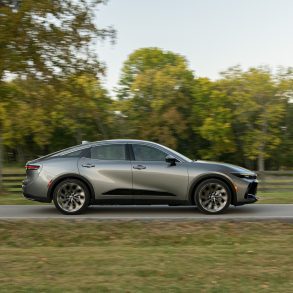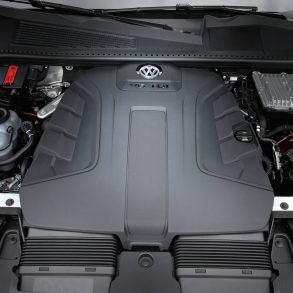 Thousands of factors contribute to one car’s poor fuel economy and another’s terrific fuel economy. Okay, perhaps not thousands. But take into consideration the following variables: temperature, driving style, the vehicle’s odometer reading, and tire pressure flux. Then there’s the most obvious possible change – the percentage of time on the highway in genuine steady state cruising and the percentage of time given to city driving. Was that city driving 10 kilometres of gridlock or 100 kilometres of daytime driving in the unpopulated suburbs?
Thousands of factors contribute to one car’s poor fuel economy and another’s terrific fuel economy. Okay, perhaps not thousands. But take into consideration the following variables: temperature, driving style, the vehicle’s odometer reading, and tire pressure flux. Then there’s the most obvious possible change – the percentage of time on the highway in genuine steady state cruising and the percentage of time given to city driving. Was that city driving 10 kilometres of gridlock or 100 kilometres of daytime driving in the unpopulated suburbs?
Thus, the “real world” fuel economy ratings you’ll receive from The Good Car Guy at FuelTheSmart or from Car & Driver in each and every issue or from Joe Blow or John Doe on the internet may have little to do with the world in which you abide. Don’t bother comparing figures from GoodCarBadCar.net’s long-term smart fortwo with summer figures in a Volvo XC70. There is a point in comparing fuel economy results, but not too fine a point.
Let’s look at a couple examples. The Environmental Protection Agency’s Fueleconomy.gov website says the Kia Forte Koup with a 6-speed manual transmission should do 22mpg in the city; 32 on the highway. The Kia Koup weighs 2,933 pounds, is powered by a 173-bhp 2.4L 4-cylinder, and gets 22mpg in Car & Driver’s hands. Meanwhile, the all-wheel drive Toyota RAV4, fitted with a 269-bhp 3.5L V6 and a 5-speed automatic is rated by the EPA as a 19/26 mpg vehicle. As tested by Car & Driver’? 24 miles per gallon.
Despite weighing in at 3,751 pounds; despite sending its power to all four wheels some of the time, despite doing so with a whole lot more power on hand being generated by a much larger engine, the Toyota RAV4 uses less fuel than the Kia Forte Koup. How so?
It may well be that the Kia Forte Koup has a bit of a problem with the bottle, if you know what I mean. What we don’t know is the nature of the route the Kia Forte Koup was driven on or the rate at which it was travelling or anything else about its time in C/D’s care. Could the Toyota RAV4 V6 simply be a remarkably efficient SUV? Indeed, that could be the case. It’s also my guess that, with most owners, a Kia Forte Koup SX would be the more fuel efficient choice over the long-term.
Here’s another tidbit. In recentissues, Car & Driver has tested two different versions of the sixth-generation Volkswagen Golf, formerly known as the Volkswagen Rabbit which had been known as the Volkswagen Golf before being known as the Volkswagen Rabbit. Back in December, the Volkswagen Golf GTI weighed in at 3,180 pounds with an as-tested price of $26,956. In February’s issue, the Volkswagen Golf TDI weighed six pounds more and had a price tag of $26,440. Granted, the options are different. More importantly, so are the engines.
The 2.0L turbodiesel in the Golf TDI generates 140 horsepower and 236 lb-ft of torque. The Good Car Guy likes this engine so much it was honoured in the Volkswagen Jetta SportWagen for The Good 12 v3.0. In the Volkswagen GTI, the 2.0L gas-fired engine is a turbocharged unit producing 200 horsepower and 207 lb-ft of torque, liked so much by The Good Car Guy that, when found in the GTI, this engine was honoured in both The Good 12 and The Good 12 v2.0. The GTI accelerates to 60mph in 6.3 seconds; the TDI needs 8.0 to do the same trick.
Now it’s time to get down to the nitty gritty Volkswagen fuel economy numbers. The GTI uses a gallon for every 24 miles driven, at least when driven by C/D’s editors. Over in diesel country, the TDI can travel an extra 10 miles for every gallon of fuel. The GTI drinks premium, too. So here we have two nearly identical cars with nearly identical pricetags and a very different form of propulsion. At current Detroit gas prices of $2.90/gallon for premium, it’s going to cost the Volkswagen GTI’s owner $1,208.34 to drive 10,000 miles. Laughing, the Volkswagen Golf TDI owner realizes he’s only going to spend $838.24 at $2.85/gallon in order to travel the same distance.
That is, if – and a big if it is – the TDI keeps going at 34mpg and the GTI stays at 24mpg. Imagine a contrary possibility. First, understand the background. Car & Driver was comparing the Volkswagen GTI with the wicked fast MazdaSpeed 3 when the GTI achieved 24mpg; under duress as the much quicker Mazda flew off into the distance. The TDI-engined Golf might have been enjoying the benefits of some editors wanting to see just how little diesel the TDI could sip. Maybe.
Knock the Volkswagen Golf TDI down to 32mpg and the Volkswagen Golf GTI up to 26mpg for argument’s sake. Now the TDI costs $890.63 to drive for a year and the GTI $1,115.38. Is this possible? Surely. And if it were to occur, the VW Golf TDI owner is saving just $8.65 per paycheque.
Interesting, no?












You can get 10 different people driving the same car over the same route and you'll get 10 different mileage figures. I know we tried this years ago at a dealership (with more than ten people) with a fuel bottle mounted on the hood for precise checking. From bad to worse on our tests there was a 10mpg variation.
Do people buy Golf TDI's at $26K or is this just how VW dresses the car up for car testers? 26K for a diesel golf????!?!